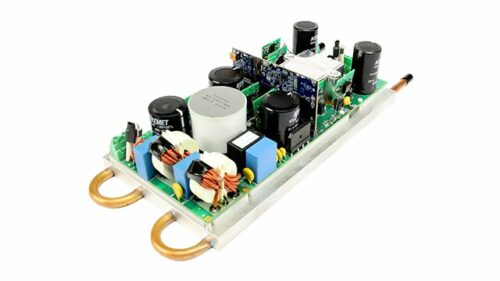Elevate the Electric Vehicle charging landscape with amplified efficiency, sleek designs, and high power density of on-board chargers.

On-board chargers (OBCs) represent a critical component in the operation of Electric Vehicles (EVs) and Hybrid Electric Vehicles (HEVs), serving as the backbone for effective battery charging. A standard OBC comprises an AC-DC converter with a power factor correction (PFC) rectifier stage and an isolated DC-DC converter, facilitating streamlined power conversion processes. As most EV Level 1 and Level 2 chargers are expected to replenish battery power fully overnight, the demand for enhanced power capabilities in OBCs is ever-growing, especially in the wake of escalating battery capacities. Consequently, the evolving designs of OBCs place a heightened emphasis on specifications like power density and efficiency. Given the constraints about space availability and cooling capacities within the vehicle, these considerations are becoming increasingly pivotal, thus necessitating meticulous planning and innovation in OBC development. Texas Instruments (TI) has launched an on-board charger reference design to simplify the design process. The TIDM-02013 reference design outlines a high-efficiency 7.4-kW, bidirectional, on-board charger, a crucial component for modern electric vehicles.
The design leverages a two-phase totem pole Power Factor Correction (PFC) and a full-bridge Capacitor-Inductor-Inductor-Inductor-Capacitor (CLLLC) converter equipped with active synchronous rectification, thereby enhancing its electrical conversion efficiency. The CLLLC converter adeptly employs frequency and phase modulation techniques to stabilise the output across a broad voltage spectrum. Central to the system’s control architecture is a singular TMS320F280039C microcontroller tasked with orchestrating both the PFC and DC-DC (Direct Current to Direct Current) conversion stages, ensuring seamless operation. The design incorporates high-speed Gallium Nitride (GaN) switches, specifically the LMG3522-Q1 model, a strategy that elevates the system to a high-density stature. This approach, consequently, realises a peak efficiency of 96.5%, paired with an open-frame power density of 3.8 kW per litre, illustrating the design’s prowess in combining power and efficiency in a compact package.
The design operates optimally at an alternating current voltage range of 90-264V, typically stabilising at 240V AC. The primary and secondary voltages are maintained at a nominal 400V DC and a range of 250-450V DC, respectively. A distinct component of this setup is the CLLLC resonant tank, which, functioning with a nominal 500-kHz PWM switching capacity, significantly facilitates higher power density. Furthermore, the design employs an advanced mechanism for soft switching, utilising Zero Voltage Switching (ZVS) on the primary side and combining ZVS with Zero Current Switching (ZCS) on the secondary side to foster higher efficiency. The OBCs are a robust solution for DC fast charging stations, facilitating quicker, more efficient power conversions. Its versatility is also evident in high-voltage battery power conversion systems, significantly optimising performance.
TI has tested this reference design. It comes with a Bill of Materials (BOM), schematics, etc. You can find additional data about the reference design on the company’s website. To read more about this reference design, click here.






In the above article CLLLC is mentioned as
Capacitive Inductive Capacitive Inductive (CLLLC)
As per Ti documentation
CLLLC (Capacitor-Inductor-Inductor-Inductor-Capacitor)
Hello mit41301,
Thanks for bringing this to our notice. We have updated the article.
Thank You